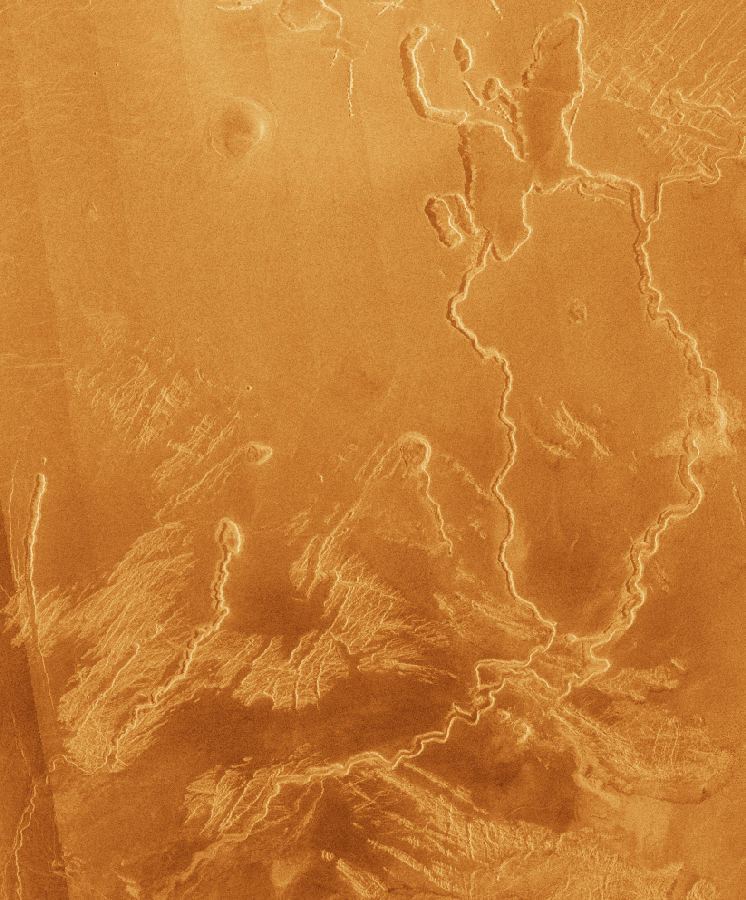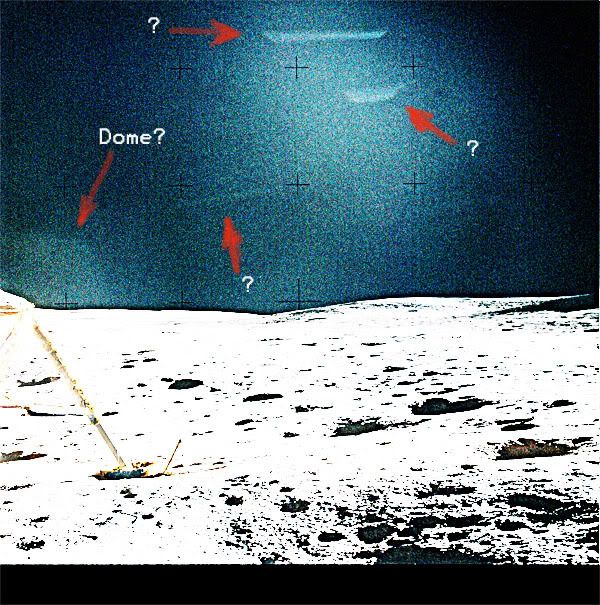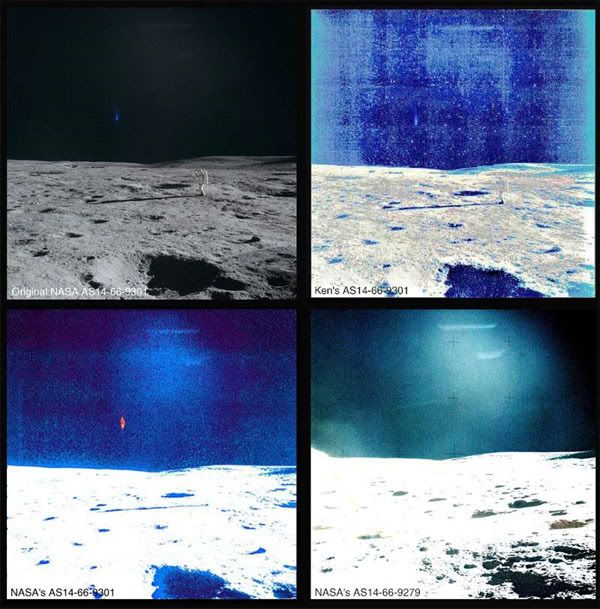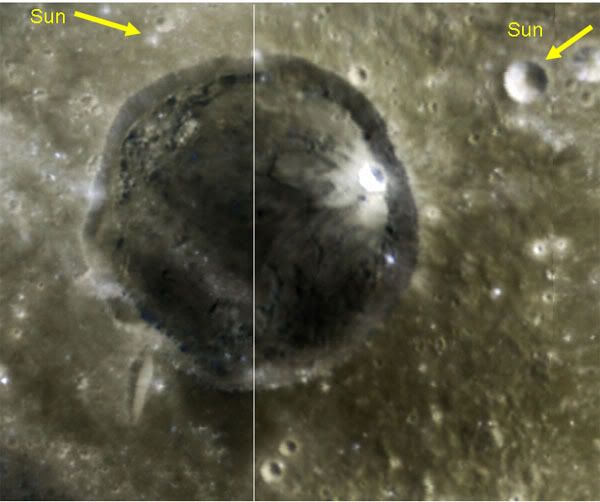It looks like you're using an Ad Blocker.
Please white-list or disable AboveTopSecret.com in your ad-blocking tool.
Thank you.
Some features of ATS will be disabled while you continue to use an ad-blocker.
share:
Originally posted by internos
Venus: Ovda Regio
Image Copyright © by Calvin J. Hamilton
Nice image of Venus, Internos...
But perhaps you could explain to us why it is that NASA uses LAVA ORANGE to colorize the images from Venus?
I mean those Magellan photos are radar images, not color photos... so are you not perpetuating NASA obfuscation by showing us NASA's LAVA ORANGE fake color images?
Originally posted by watchZEITGEISTnow
Wowzers! Nice screen grab... to me that is a dome, see through too!
Couple more for you....
Mare Crisium has long been 'rumored' to have a glass dome on the 'shore'
Well from the Clementine images when you look at Mare Crisium you will see this bright glaring reflection of the sun

There is also the one we call "Glass Biosphere"

Now before anyone goes discussing the angle of the sunlight be aware that it is in TWO directions in this image.... ( figure that out yourselves )
Just for those that care about what is really going on...
LUNAR AND MARTIAN FIBERGLASS AS A VERSATILE FAMILY
OF ISRU VALUE-ADDED PRODUCTS
by Gary "ROD" Rodriguez, Systems Architect, sysRAND Corporation
Lunar Regolith consists principally of silicates, in some cases as volcanic or impact glasses. We continue to contend that silicon is more versatile in application than all of the other Lunar available elements combined and shouldn't end up in Lunar slag heaps and instead should be the fundamental building block for a wide range of value-added products in a CisLunar economy. Fabrication of silicate glasses are conventional industrial processes and anticipated tensile strength of glass made under hard vacuum is an order of magnitude greater than glass produced in atmosphere containing water vapor.
The logic employed in our reasoning includes the fact that any In Situ Resource Utilization (ISRU) effort is going to yield copious masses of silicon oxides which can be used in bulk as conventional glass products or, after further separation, can be synthesized as Silicon and Silicon- Carbide Fullerenes for more exotic applications. Additionally, mechanical wrapping of Silicon Webbing could prove to be more practical and durable and a lot less brittle than attempting large scale hot glass molding of structural components.
Identified fuel production ISRU efforts yield partially heated masses of metal oxides as waste byproduct – rich in silicates and metal oxides useful in bulk as conventional glass products. Fiberglass manufacturing increases effectiveness of prior ISRU fuel production by taking advantage of mineral benefaction and elevated process exit temperatures. The resulting structures would be spheres and cylinders with various configurations that could apply to human support systems, along with structures useable as storage tanks for the very Oxygen liberated in ISRU applications.
ISRU can manufacture more than fuels: even spacecraft are feasibly and affordably manufactured on Moon based upon fiberglass "tankage" integrated with fiberglass keels. Second generation structural components may take advantage of Silicon Nanotubes for additional composite strength. Diverse products for human systems support are manufacturable in-situ using glass fibers and fabrics, and CNC-type programmable manufacturing delivering state-of-the-art flexibility of remote design and parts manufacture. These concepts suggest extensibility and evolutionary capability derived when machining tool parts from fiberglass.
Contemporary Terrestrial industrial composite fiber products range from pressure vessels to lightweight sporting goods. A large number of products related to human systems support can similarly be manufactured in-situ using fiber fabric made from lunar silicate glass. Building structures using spun glass would be similar to those currently employed by Raytheon Aircraft or Scaled Composites to build composite aircraft. Pressure containers, structural components, woven fiberglass fabrics, molded and machined solid objects, glass fiber and filament are each large classes of value-added products.
This file is in the public domain available on CD from LPI
Mod Edit: Image Hotlinking – Please Review This Link.
[edit on 6/1/2009 by Mirthful Me]
Originally posted by zorgon
But perhaps you could explain to us why it is that NASA uses LAVA ORANGE to colorize the images from Venus?
I mean those Magellan photos are radar images, not color photos... so are you not perpetuating NASA obfuscation by showing us NASA's LAVA ORANGE fake color images?
I've mentioned the type of device used by magellan in the very same post, you just would have to scroll it down and you would have found in the description that i mentioned Synthetic Aperture Radar: i've shared the informations available and the image, as ive found them: nothing more, nothing less
now, if we'd start pointing out who posts false color (or even CGI) images, not to mention bicubic resamples which ARE CGI, since they are images generated by the computer using a bicubic algorithm, (like your enlargement of the crater in this post where i don't see that you pointed out that it was an enlargement made using a bicubic resampling method ), it would come out a very long list:
moreover, the purpose was to show the SHAPES of the rilles, not their colors, so it doesn't matter whether the color is false or not
[edit on 1/1/2009 by internos]
reply to post by zorgon
Regarding In Situ Resource Utilization on the Moon (and Mars) I have found a very interesting document which is available online, and which I highly recommend reading. It is called "WORKSHOP ON USING IN SITU RESOURCES FOR CONSTRUCTION OF PLANETARY OUTPOSTS", and the document is from 1998. I wonder if perpaps some of the things discussed in the workshop already are a reality..?
In this document you can among other things read about
"CONSTRUCTION OF PLANETARY HABITATION TUNNELS USING A ROCK-MELT-KERFING TUNNEL-BORING MACHINE POWERED BY A BIMODAL HEAT PIPE REACTOR" (page 26):

Tunnel Borer Concept (Rock melt kerfing for tunnel support)
From page 2 in the document:
www.lpi.usra.edu...
Regarding In Situ Resource Utilization on the Moon (and Mars) I have found a very interesting document which is available online, and which I highly recommend reading. It is called "WORKSHOP ON USING IN SITU RESOURCES FOR CONSTRUCTION OF PLANETARY OUTPOSTS", and the document is from 1998. I wonder if perpaps some of the things discussed in the workshop already are a reality..?
The workshop examined the potential uses of indigenous materials on the Moon and Mars, other than those uses associated with the production of propellants for space transportation. The use of indigenous propellants has become an accepted requirement for human exploration missions to Mars and in building permanent outposts on the Moon. The papers presented in the workshop concerned the needs for construction, based on analysis of the current NASA Mars Reference Mission and past studies of lunar outposts; the availability of materials on the Moon and Mars; construction techniques that make use of the natural environment; materials production and fabrication techniques based on indigenous
materials; and new technologies that could promote the use of indigenous
materials in construction.
In this document you can among other things read about
"CONSTRUCTION OF PLANETARY HABITATION TUNNELS USING A ROCK-MELT-KERFING TUNNEL-BORING MACHINE POWERED BY A BIMODAL HEAT PIPE REACTOR" (page 26):

Tunnel Borer Concept (Rock melt kerfing for tunnel support)
From page 2 in the document:
Significant manned exploration and support activities over extended
periods on planetary surfaces such as the Moon or Mars will require space radiation shielding of habitats and laboratories. As habitat volumes grow, it will soon become cost effective in structural mass import and extravehicular activity (EVA) time to construct habitable volumes directly underground in the form of gas-tight tunnels incorporating many meters of overburden shielding. We have previously proposed [1] that an effective concept for constructing such tunnels is a tunnel-boring machine (TBM) design that combines conventional rotary (auger) cutters with rock-melting kerf heaters, the latter to control the tunnel gauge dimension in poorly consolidated rock and provide support for the opening. Advantages
of this approach are (1) no fluids are needed to transport cuttings and
(2) tunnel support in the form of a strong, impermeable glass lining
is automatically formed as the TBM advances.
www.lpi.usra.edu...
reply to post by ziggystar60
Looks a lot in concept like this machine:

and some of the stuff from this page:
www.thelivingmoon.com...
Mod Edit: Image Hotlinking – Please Review This Link.
[edit on 6/1/2009 by Mirthful Me]
Looks a lot in concept like this machine:

and some of the stuff from this page:
www.thelivingmoon.com...
Mod Edit: Image Hotlinking – Please Review This Link.
[edit on 6/1/2009 by Mirthful Me]
Originally posted by zorgon
There is also the one we call "Glass Biosphere"
Personally that is what I would call "crater" and "optical illusion". Its well known that the eye can be fooled into confusing convex and concave surfaces seen from the above.
Anyway, not having read through the entire thread... Has there ever been even ONE additional image of the same area provided as evidence for an anomaly? I mean from another mission (or at least other angle), preferably with different resolution?
That would go quite far to "set the controversy to rest".
But alas... All I see is the same random-found-shape images we've seen over and over again, as if posting them again provide even more proof than the first time they where posted.
Mod Edit: Image Hotlinking – Please Review This Link.
[edit on 6/1/2009 by Mirthful Me]
Originally posted by zorgon
Couple more for you....
Mare Crisium has long been 'rumored' to have a glass dome on the 'shore'
Well from the Clementine images when you look at Mare Crisium you will see this bright glaring reflection of the sun
There is also the one we call "Glass Biosphere"
Wooah nelly! That's just incredible evidence (again). I'm blown away dude. This stuff is so clear to me now...I am stunned that up until a year ago I knew NOTHING of this kind of info. Please hurry up with that book of yours!
The reflections make so much sense. I still think Internos wants to believe, but his mind won't let him (he is a clever fella though, no dispute).
wZn
Mod Edit: Image Hotlinking – Please Review This Link.
[edit on 6/1/2009 by Mirthful Me]
I have posted a cropped image from Apollo 17 just before it started its journey back home.
I also binned it using a Mitchel filter to make it easier to see here.
I circled the areas I found of interest. The one area which is circled with a rectangular section inside looks to my like a ship canopy.
There is much more in this image then I have highlighted, in fact its a very busy image in my humble opinion.
Also take note that the image has been made into a negative for clarity.
I see no evidence of tampering with this image and hope its of value here.
While its not a crater, it does look like a ship of considerable size.
All circled areas look to me like transports of some sort. There also looks to be a contrail? coming from one of the circled areas. The rectangular highlights look to me like beings.
Not much else to say other than thanks to the OP for a great topic.
Nasa info of image: Rev 15. Crater Amici, Crater Icarus.
Link to the original:
history.nasa.gov...
Many thanks to Nasa for the use of this image.
files.abovetopsecret.com...
I also binned it using a Mitchel filter to make it easier to see here.
I circled the areas I found of interest. The one area which is circled with a rectangular section inside looks to my like a ship canopy.
There is much more in this image then I have highlighted, in fact its a very busy image in my humble opinion.
Also take note that the image has been made into a negative for clarity.
I see no evidence of tampering with this image and hope its of value here.
While its not a crater, it does look like a ship of considerable size.
All circled areas look to me like transports of some sort. There also looks to be a contrail? coming from one of the circled areas. The rectangular highlights look to me like beings.
Not much else to say other than thanks to the OP for a great topic.
Nasa info of image: Rev 15. Crater Amici, Crater Icarus.
Link to the original:
history.nasa.gov...
Many thanks to Nasa for the use of this image.
files.abovetopsecret.com...
Can anyone provide a higer res version of the picture that is called the smoking gun "tower" photo? Is it in any of the clementine images or any of
the other photos that have been taken of the moon in the last 20 years? I'd really like to see the same area just to get a basis for comparison.
Originally posted by mikesingh

AS14-66-9279HR
Courtesy: NASA
With enhanced B/C. I have marked the anomalous objects/structure with red arrows….
www.hq.nasa.gov...
I'd add a couple of cents here. That appears to be from the focusing plate at an extreme angle. Light leaks are hardly rare and only requires that the light be at the right angle and the photographer not use a good eye cup which I doubt they had on those cameras. That shape screams at me it is from light leaked through the eyepiece and off the focusing plate via the prism in the eyepiece. The light probably leaked due to the faceplate between the astronauts eye and the eyepiece.
The other could be due to the actual curved faceplate adding its reflected light to the mix.
That gap between the eye of the photographer and the eyepiece would pretty much guarantee you will find this in many photo's.
Since this is so common most people including me, use a cover for the eyepiece when taking shots where our eye does not cover and protect against the leak. The astronauts faceplate would make this impossible to protect against.
I'm 99.99999999999999999999999999999999999999% positive on this one.
Originally posted by watchZEITGEISTnow
I still think Internos wants to believe, but his mind won't let him (he is a clever fella though, no dispute).
wZn
I went back an read his take on this. His mind won't let him because he is correct and rational.
You need to learn about the illusions caused by viewing concave or convex surfaces. If your interested in truth that is.
I've seen enough pictures of anomalies on the Moon to believe that there is undoubtedly something unusual going on there. However, I don't think
that this picture is proof of it. Pictures taken on the Moon are always going to look a little strange...because they are pictures taken on the Moon.
reply to post by Blaine91555
So perhaps you can explain the blatant reflections in those pictures?
A rational illusion is an oxymoron I reckon. Anyway you be happy being rational and I'll stick to being happy and irrational. Meanwhile I'll stand by what I see in these pictures - domes big and reflecting the sunlight.
wZn
So perhaps you can explain the blatant reflections in those pictures?
A rational illusion is an oxymoron I reckon. Anyway you be happy being rational and I'll stick to being happy and irrational. Meanwhile I'll stand by what I see in these pictures - domes big and reflecting the sunlight.
wZn
Originally posted by atzmaz
Can anyone provide a higer res version of the picture that is called the smoking gun "tower" photo?
Check out my thread here for all the details you want on that 'smoking gun' image. Uncensored NASA Moon Images!!
Is it in any of the clementine images or any of the other photos that have been taken of the moon in the last 20 years? I'd really like to see the same area just to get a basis for comparison.
Unfortunately, I haven't come across any. But remember some of the images taken by the LO seem to have better resolution than the Apollo/Clementine images. This particular 'tower' image was taken from just 40km above the Lunar surface, probably the reason for the fair amount of clarity.
Cheers!
reply to post by Blaine91555
I think that's a fair explanation! That glare in the image could be the result of the reflection from the astronaut's visor whilst taking the pic. The lens flare explanation has been brought out by internos too.
Good! Now we seem to be getting nearer to dumping Hoagy's favorite theory that those are glass structures! He's bet his life on it with voluminous explanations in favor of his theory - which he claims is a fact!!
Now let's see what he says on it not being lens flare etc...
Courtesy: Enterprise Mission
The bottom two are different images taken from slightly displaced locations showing the same anomalies. Now this is what he has to say...
Huh??
So now how do we catch him by his ba##s? And then we need to tell him that his theories on those glass structures that he has shown as proof don't hold much water like his so called 'vegetation-on-Mars' pics which was debunked by me some time ago on another thread!
Darn! I wish we could get him on ATS to sort it out once and for all! But I don't think he'll bite knowing what he'll be up against!!
More explanations by Hoagy here...www.enterprisemission.com...
Cheers!
I think that's a fair explanation! That glare in the image could be the result of the reflection from the astronaut's visor whilst taking the pic. The lens flare explanation has been brought out by internos too.
Good! Now we seem to be getting nearer to dumping Hoagy's favorite theory that those are glass structures! He's bet his life on it with voluminous explanations in favor of his theory - which he claims is a fact!!
Now let's see what he says on it not being lens flare etc...
Courtesy: Enterprise Mission
The bottom two are different images taken from slightly displaced locations showing the same anomalies. Now this is what he has to say...
The mass you see in the above images is not caused by a lens flare. The astronaut's shadow in the first three images shows that the sun is coming in at a right angle to the camera axis -- thus eliminating the potential for such a mundane explanation.
Lens flares require the light source to be either in-frame or directly outside of it in order to illuminate the camera lens. In this case, it is impossible to illuminate the lens, due to the right-angle offset position of the sun.
Huh??
So now how do we catch him by his ba##s? And then we need to tell him that his theories on those glass structures that he has shown as proof don't hold much water like his so called 'vegetation-on-Mars' pics which was debunked by me some time ago on another thread!
Darn! I wish we could get him on ATS to sort it out once and for all! But I don't think he'll bite knowing what he'll be up against!!
More explanations by Hoagy here...www.enterprisemission.com...
Cheers!
Originally posted by Blaine91555
I'm 99.99999999999999999999999999999999999999% positive on this one.
Well I am glad you left .00000000000000000000000000000000000001% for an error margin...
Since the Hasselblad Camera used by the Apollonauts was chest mounted so they never sighted through it. Besides the 'eyepiece' on a Hasselblad is a square window on top of the camera, which in the case of the Apollo cameras was sealed
,,
[edit on 2-1-2009 by zorgon]
Originally posted by mikesingh
Darn! I wish we could get him on ATS to sort it out once and for all! But I don't think he'll bite knowing what he'll be up against!!
So now one Anomaly hunter tears down the castles of another Anomaly hunter..
Interesting development
Originally posted by zorgon
There is also the one we call "Glass Biosphere"
Now before anyone goes discussing the angle of the sunlight be aware that it is in TWO directions in this image.... ( figure that out yourselves )
Yep! Figured out! It's actually two images stitched together! See below..
Now why the dickens have they done this? The right half shows that formation to be a sphere with light reflecting off the convex surface, whereas the left portion seem to be concave.
WTF?
Cheers!
Mod Edit: Image Hotlinking – Please Review This Link.
[edit on 6/1/2009 by Mirthful Me]
Originally posted by zorgon
So now one Anomaly hunter tears down the castles of another Anomaly hunter..
Interesting development
Oh well! Just Ego problems!!
[edit on 2-1-2009 by mikesingh]
Originally posted by mikesingh
Now why the dickens have they done this? The right half shows that formation to be a sphere with light reflecting off the convex surface, whereas the left portion seem to be concave.
WTF?
Two passes of Clementine... just happens the overlap is right through the center...

Mod Edit: Image Hotlinking – Please Review This Link.
[edit on 6/1/2009 by Mirthful Me]
new topics
-
World's Best Christmas Lights!
General Chit Chat: 2 hours ago -
Drone Shooting Arrest - Walmart Involved
Mainstream News: 2 hours ago -
Can someone 'splain me like I'm 5. Blockchain?
Science & Technology: 3 hours ago -
Squirrels becoming predators
Fragile Earth: 4 hours ago -
Labour's Anti-Corruption Minister Named in Bangladesh Corruption Court Papers
Regional Politics: 5 hours ago -
Have you noticed?? Post Election news coverage...
World War Three: 5 hours ago -
Georgia appeals court disqualifies DA Fani Willis from Trump election interference case
US Political Madness: 7 hours ago
top topics
-
Georgia appeals court disqualifies DA Fani Willis from Trump election interference case
US Political Madness: 7 hours ago, 24 flags -
Have you noticed?? Post Election news coverage...
World War Three: 5 hours ago, 11 flags -
Squirrels becoming predators
Fragile Earth: 4 hours ago, 8 flags -
Labour's Anti-Corruption Minister Named in Bangladesh Corruption Court Papers
Regional Politics: 5 hours ago, 6 flags -
Drone Shooting Arrest - Walmart Involved
Mainstream News: 2 hours ago, 5 flags -
World's Best Christmas Lights!
General Chit Chat: 2 hours ago, 5 flags -
Can someone 'splain me like I'm 5. Blockchain?
Science & Technology: 3 hours ago, 3 flags
active topics
-
-@TH3WH17ERABB17- -Q- ---TIME TO SHOW THE WORLD--- -Part- --44--
Dissecting Disinformation • 3760 • : 777Vader -
Can someone 'splain me like I'm 5. Blockchain?
Science & Technology • 26 • : Flyingclaydisk -
Have you noticed?? Post Election news coverage...
World War Three • 6 • : rickymouse -
Russias War Against Religion in Ukraine
World War Three • 46 • : andy06shake -
Squirrels becoming predators
Fragile Earth • 24 • : rickymouse -
Drone Shooting Arrest - Walmart Involved
Mainstream News • 12 • : BeyondKnowledge3 -
The Mystery Drones and Government Lies --- Master Thread
Political Conspiracies • 144 • : charlyv -
US Federal Funding set to Expire December 20th. Massive CR on the way.
Mainstream News • 26 • : burntheships -
It's time to dissect the LAWFARE
Dissecting Disinformation • 18 • : burntheships -
World's Best Christmas Lights!
General Chit Chat • 5 • : onestonemonkey






